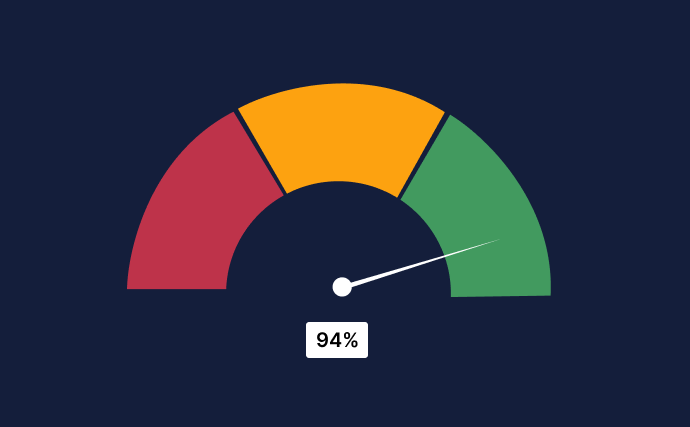What Is Competitor Benchmark Data & Why Should You Analyse It?

When evaluating how to improve your business and its operations, you sometimes have to look outside of your company and its goals, so you can establish what your competitors are doing differently – and most importantly, better. That’s why so many companies look at benchmarking data to understand what they’re doing right, and what they could improve upon based on this type of competitor analysis.
If you’re interested in finding out more about competitive benchmarking and the type of data you can collate, check out all the details in our blog below…
So…what is competitive benchmarking?
Put simply, competitive or external benchmarking is an organised process businesses take upon themselves to compare their operations, products, services, and other processes with industry competitors. Businesses performing competitive benchmarking will take time to analyse key performance metrics and best strategies so they can better understand how they can improve within their industry.
Understanding what successes and drawbacks competitors are experiencing helps a business make better, well-informed decisions about its own company model and internal systems. Once the competitor benchmarking has been completed, businesses can then set realistic goals and implement similar strategies to achieve success in a saturated market or competitive industry.
What is competitor benchmark data?
To perform benchmarking, businesses have to collect specific competitor benchmarking data. This is so they can observe and understand tangible evidence that demonstrates what a business is doing to succeed. This type of data encompasses both qualitative and quantitative information, meaning it pertains to several different types of metrics such as:
- Product quality
- Pricing
- Market share
- Customer satisfaction; and
- Much more
The type of data a business chooses to benchmark against will depend on its own goals. For example, if they want to better understand why a competitor gets more traffic at a trade show, they might look at footfall trends and interaction rates. Ultimately, this type of data informs strategic decision-making, so business leaders can establish where their business falls behind and why.
For more information on how to stand out at a trade show, check out our ultimate exhibition guide.
Why do businesses look at competitor benchmarking data?
Businesses consider and analyse competitor benchmarking data so they can better understand their own rights and wrongs when it comes to appealing to their customers and increasing sales. For example, they might want to:
Improve performance
One reason why businesses look at competitor benchmarking data is so they can improve their overall performance. If a competitor is yielding success and the results your business needs to succeed, analysing their internal and external process can help you better understand the ways in which your business could change based on this information. As a result, you could implement similar, successful practices, and improve the sales of your company.
Understand competition
Another reason why businesses review and source competitor benchmarking data is so they can understand the market and their direct competition. It’s hard to be an industry leader when you have little knowledge of your industry and the competitors that pave the way. This is why benchmarking can be so useful, as it presents tangible evidence of how and why your competitors are doing better. Ultimately, with this understanding, you can reevaluate some of your own business practices, so you can be more efficient, attract more customers, or even retain staff for longer.
Identify gaps and best practices
Benchmarking data helps businesses identify gaps in their company and ways they can improve based on the successful practices of their competitors. By looking at benchmarking data, they’ll obtain the knowledge they need to understand their strengths and weaknesses and make improvements based on this.
What steps are involved in the competitor benchmarking process?
The competitor benchmarking process might differ depending on which avenue you choose to pursue, but the steps to each one are still similar. They include:
Plan and prepare
The most crucial step in the competitor benchmarking process is ensuring your business has properly planned and prepared. This means defining objectives, selecting the most applicable competitors, and identifying the metrics or data you will use to compare this. With a well structured plan, you can draw more accurate comparisons, and ultimately create action points that will have a positive impact on your business.
Identify competitors
As part of the planning process, you will have already identified competitors you want to draw comparisons from. To do so, you might want to group these into two different categories: direct competitors and indirect competitors. The former assesses competitors offering the same as you, and the latter looks at similar-sized businesses in which you can replicate their successful operations and processes. To help you pick both, analyse market leaders and emerging industry players, as well as customer feedback.
Collect and analyse data
Next, you’ll need to collect and analyse data. It might sound simple enough, but in today’s world where obtaining sensitive information is heavily legislated, this can be a difficult task. Ensure you consider and identify ways you can obtain this information in line with GDPR and data protection rules, as well as how you plan to collate it in a way that protects sensitive data.
Create an action plan
Now you’ve collected and evaluated the data (lawfully) you can create an action plan from the results you’ve drawn. To do so, ensure you outline the processes and strategies you can implement to effectively make an improvement, as well as a timeline with achievable goals.
Implement and document improvements
Now you’ve successfully benchmarked, it’s time to implement these improvements – and document your progress. Use key performance indicators to understand how your business progresses over the timeline you’ve set. Ensure you use real-time monitoring to make changes where you see fit and be ready to adapt if/when something goes wrong. This approach will give you the best chance of seeing improvements in your business model and make benchmarking a meaningful process you can return to.
Identify competitor benchmarking analysis with a free demo from Exposure Analytics
It’s important you know what your position is within your specific market. To do so, you need to analyse your performance against your competitors. And if you’re unsure where to start, we can make it easy for you at Exposure Analytics.
Get in touch with Exposure Analytics today at 0203 982 0997 to find out how you compare to your competitors with a free demo. A member of our expert team will listen to your needs and demonstrate how our competitive benchmarking software can help you achieve your business goals and stand out in your market.
Competitive benchmarking data: FAQs
Are there different types of competitive benchmarking?
Yes, there are two main types of benchmarking analysis you can use to gain a competitive advantage in your industry. These include:
- Performance benchmarking: This process considers a specific competitor system, application, or other component against your own business to understand your company’s performance in comparison. For example, a business might look at key metrics such as market share, customer satisfaction, and company operations.
- Strategic benchmarking: This type of benchmarking looks at the operation system or business model of a competitor, so it can be compared to a company’s overall business style.
- Process benchmarking: Process benchmarking refers to the type of benchmarking that specifically looks at your business’s internal processes in comparison with competitors.
For information on the other types of benchmarking you can choose from, check out our blog.
What challenges come with benchmarking?
Like any type of competitor analysis, benchmarking comes with its own set of challenges. Learn what they are below so you can anticipate them when using benchmarking data:
- Data interpretation: If those performing the benchmark misinterpret any of the data it can lead to the wrong conclusions being drawn. As a result, the processes they adopt might be redundant.
- Varied business models and practices: It can be difficult to draw direct comparisons with some types of benchmarking as business models and practices can be entirely varied. Moreover, not all benchmarking tools will measure every aspect of real-world performance.
- Imitation over improvement: Instead of adapting their own company models, some businesses might just replicate their competitors. This can be counterproductive because direct imitation overlooks the nuances that supported the competitor’s success – and therefore won’t produce the best results.


